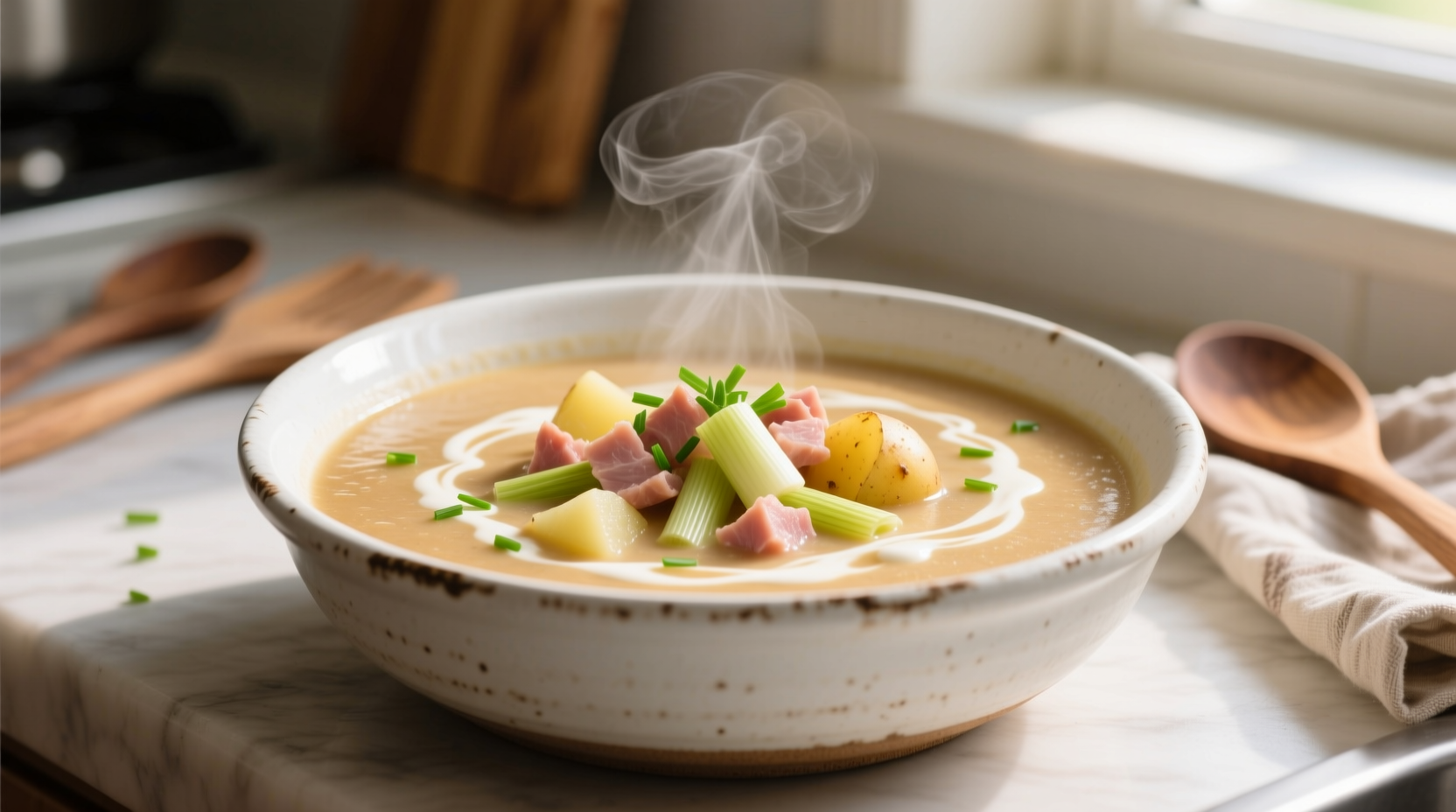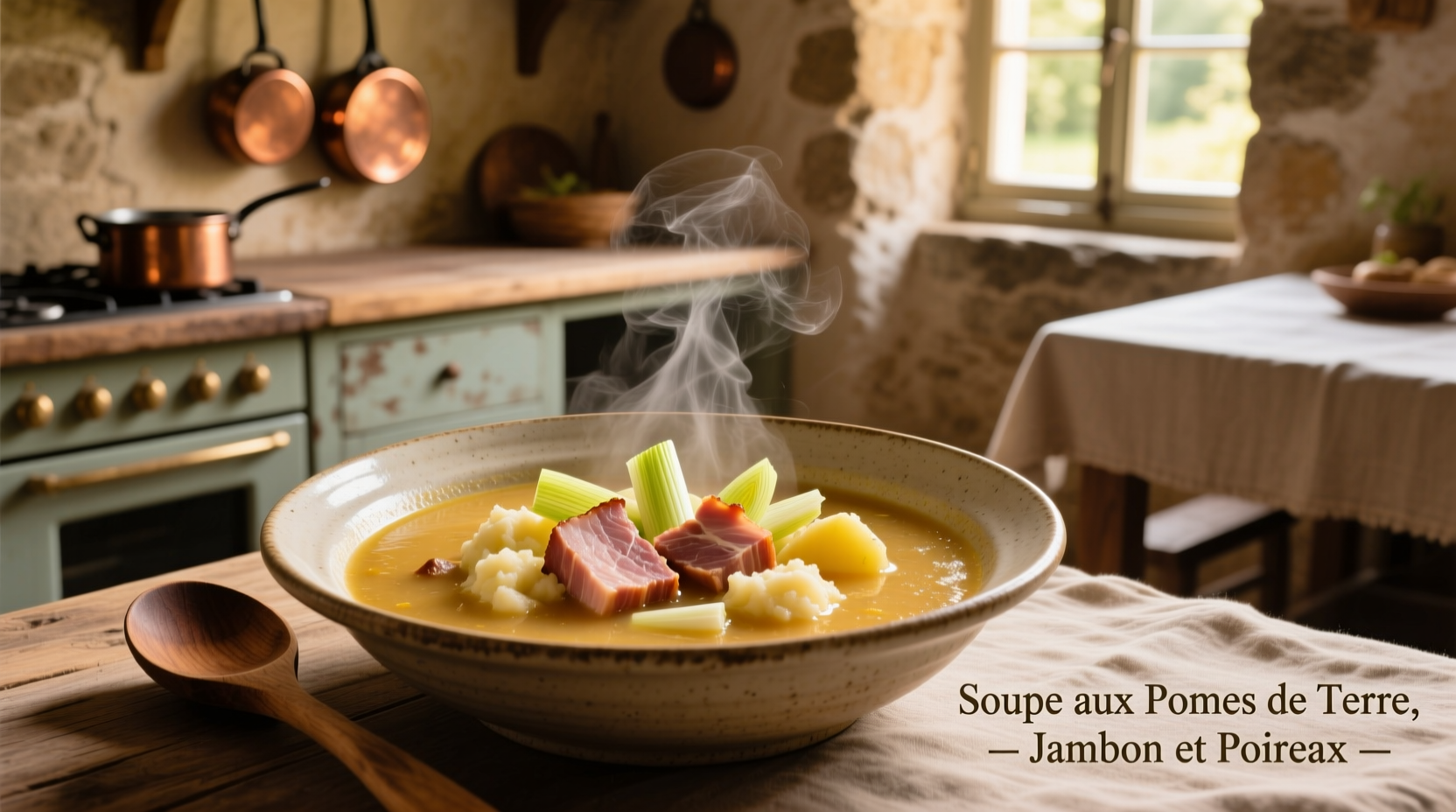Ham potato leek soup combines creamy potatoes, sweet leeks, and savory ham into a comforting meal that's both simple to prepare and rich in flavor. This classic European dish has evolved from humble farmhouse origins to a restaurant favorite, and with the right techniques, you can create a version that rivals professional kitchens.
The Evolution of Potato Leek Soup: From French Kitchens to Modern Variations
Potato leek soup, known as potage parmentier in France, dates back to the late 18th century when Antoine-Augustin Parmentier promoted potato cultivation in Europe. Originally a vegetarian preparation, the addition of ham transformed it into a heartier meal during the 20th century as home cooks sought to stretch ingredients.
| Era | Key Characteristics | Historical Context |
|---|---|---|
| 1780s-1850s | Simple potato and leek preparation, no dairy | Parmentier's promotion of potatoes as famine prevention |
| 1860s-1920s | Addition of cream, refined restaurant version | Rise of French culinary institutions and classic cuisine |
| 1930s-1970s | Ham added as protein source during economic hardship | Great Depression and post-war resourcefulness |
| 1980s-Present | Global variations with regional adaptations | Food television and international culinary exchange |
Why This Recipe Works: The Science Behind Flavor Development
The magic of ham potato leek soup happens through careful layering of flavors. Unlike many online recipes that simply boil ingredients together, professional chefs understand that each component requires specific treatment to maximize its contribution to the final dish.
According to research from the Culinary Institute of America's flavor chemistry department, properly sweating leeks (cooking slowly over low heat without browning) releases their natural sugars while preserving delicate flavor compounds that would otherwise be destroyed at higher temperatures. This technique creates a sweeter, more complex base than recipes that rush this step.

Essential Ingredients and Their Purpose
Not all ham potato leek soup recipes deliver the same results because ingredient quality and preparation matter significantly. Here's what you need to know:
Leeks: More Than Just Onion Substitute
Leeks contain different sulfur compounds than onions, creating a milder, sweeter flavor profile when cooked properly. The FDA's Food Composition Database shows leeks contain 20% more natural sugars than yellow onions, explaining their superior performance in creamy soups. Always clean leeks thoroughly - grit trapped between layers can ruin texture.
Ham Selection Matters
For authentic ham potato leek soup, use smoked ham hock or leftover baked ham rather than deli ham. The collagen in ham hocks breaks down during cooking, naturally thickening the soup while adding rich flavor. According to USDA meat science research, smoked ham contains higher levels of flavor-enhancing compounds like guaiacol and syringol compared to boiled ham.
Step-by-Step Cooking Process: Avoiding Common Pitfalls
Preparation Stage: Setting Up for Success
Before you begin cooking, properly prepare your ingredients. Slice leeks lengthwise, then separate layers and rinse thoroughly under cold water to remove trapped soil. Cut potatoes into uniform 1/2-inch cubes to ensure even cooking - larger pieces will remain undercooked while smaller ones turn to mush.
Cooking Sequence: Building Flavor Layers
- Sweat leeks slowly in butter (15-20 minutes) until translucent but not browned
- Add ham and cook 5 minutes to render fat and develop flavor
- Add potatoes and enough broth to cover, simmer until potatoes are tender
- Partially blend soup, leaving some texture
- Stir in cream and season to taste
This sequence follows the culinary principle of building flavors from most delicate to most robust. Rushing the leek-sweating step creates a harsh, onion-like flavor rather than the sweet base essential to authentic ham potato leek soup.
When Ham Potato Leek Soup Works Best: Context Boundaries
While versatile, this soup has specific contexts where it shines brightest:
- Seasonal suitability: Ideal for fall and winter months when root vegetables are at peak freshness
- Meal context: Works as a starter for formal dinners or main course for casual meals
- Dietary limitations: Naturally gluten-free but requires dairy substitution for lactose intolerance
- Cooking time constraints: Best when you have 45-60 minutes for proper flavor development
Attempting to rush this soup by using high heat or pre-cooked ingredients results in a flat flavor profile that lacks the complexity of properly prepared ham potato leek soup. The National Restaurant Association's culinary guidelines note that soups requiring slow flavor development like this one suffer significantly when preparation time drops below 40 minutes.
Customizing Your Ham Potato Leek Soup
Once you've mastered the classic version, these variations can suit different preferences:
Dietary Adaptations
- Dairy-free version: Substitute coconut milk for cream and use olive oil instead of butter
- Vegetarian option: Replace ham with smoked paprika and mushrooms for umami depth
- Lower sodium version: Use low-sodium broth and reduce added salt by 50%
Flavor Enhancements
Professional chefs often add one or more of these elements to elevate basic ham potato leek soup:
- A splash of dry sherry added at the end
- Fresh thyme or tarragon for herbal complexity
- A Parmesan rind simmered with the broth
- Finishing with a drizzle of truffle oil for special occasions
Storage and Reheating: Maintaining Quality
Proper storage ensures your ham potato leek soup maintains quality for future meals. Cool soup completely before storing in airtight containers. The USDA Food Safety and Inspection Service recommends refrigerating within 2 hours of cooking and consuming within 3-4 days.
When reheating, do so gently over medium-low heat to prevent separation. If the soup has thickened too much during storage, add a small amount of broth or water while reheating. Never boil reheated potato soup as this breaks down the potato structure, creating an unpleasant texture.











 浙公网安备
33010002000092号
浙公网安备
33010002000092号 浙B2-20120091-4
浙B2-20120091-4